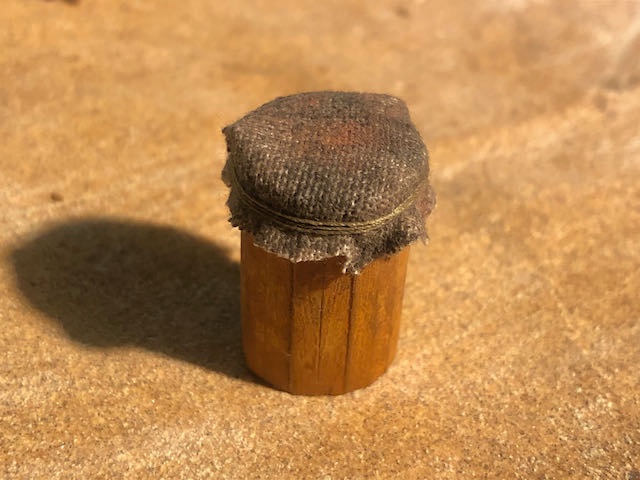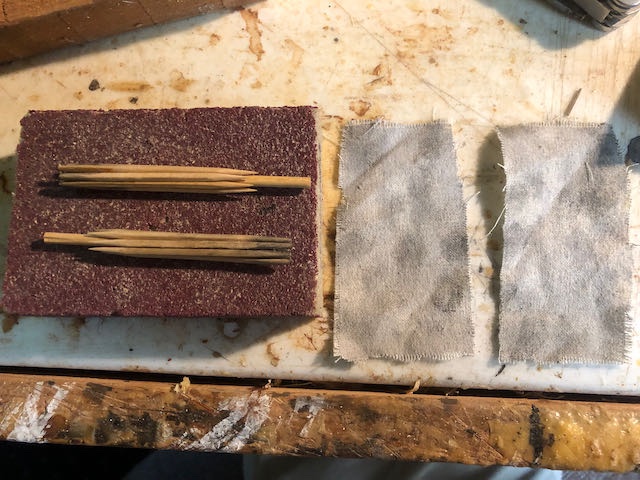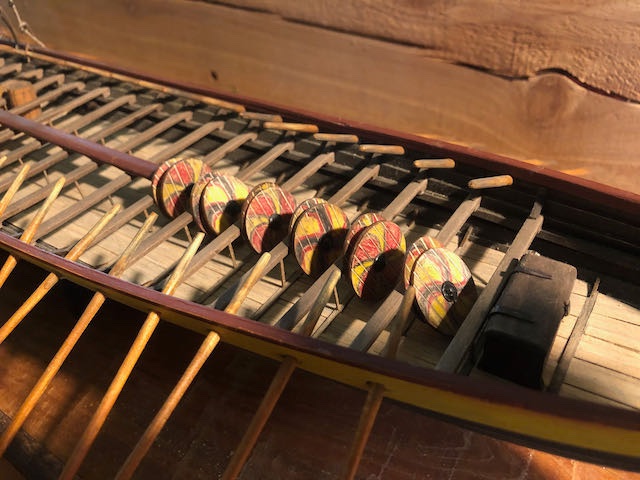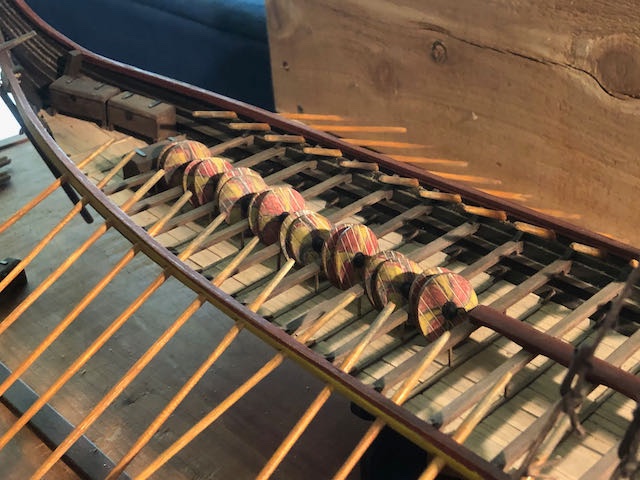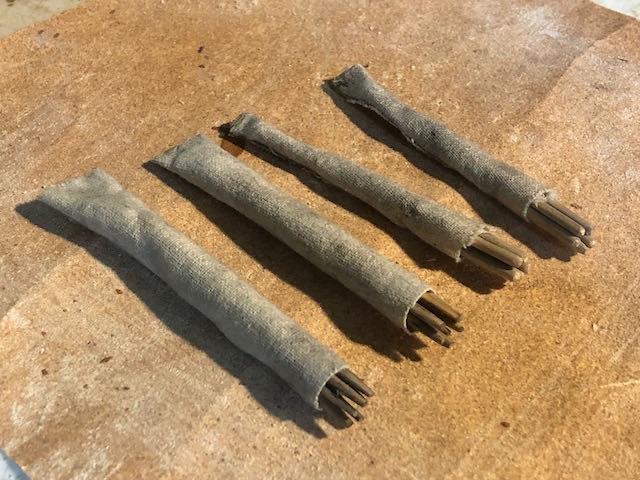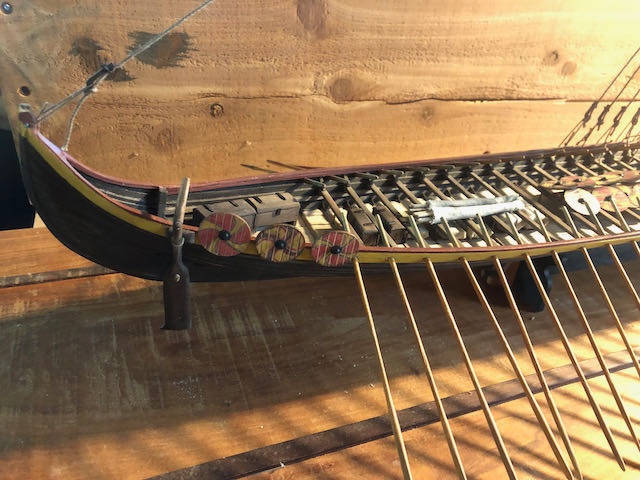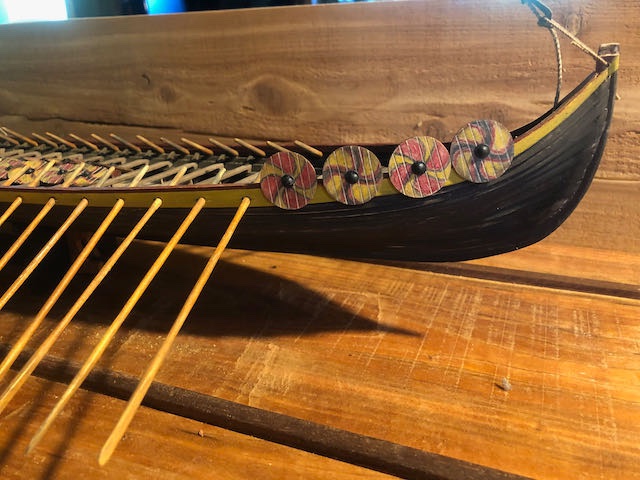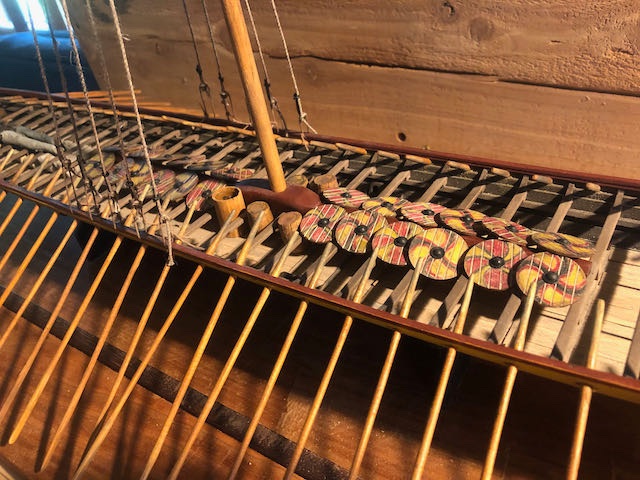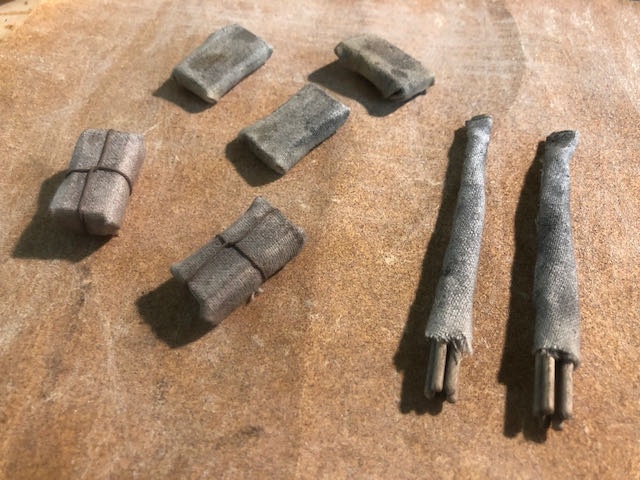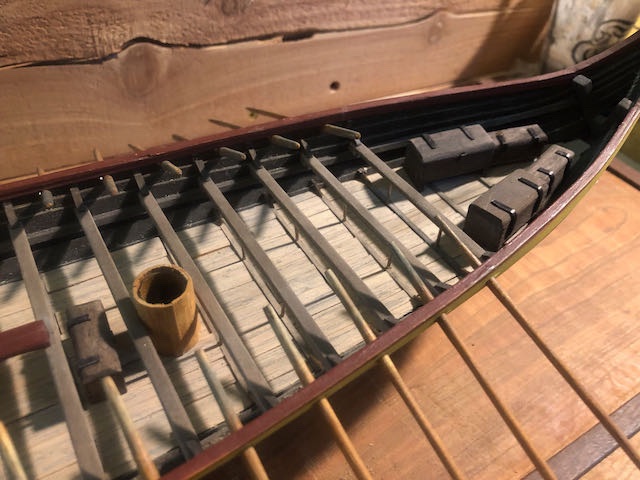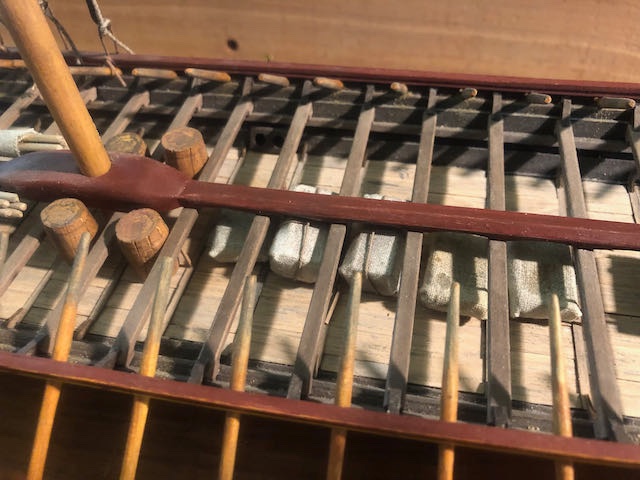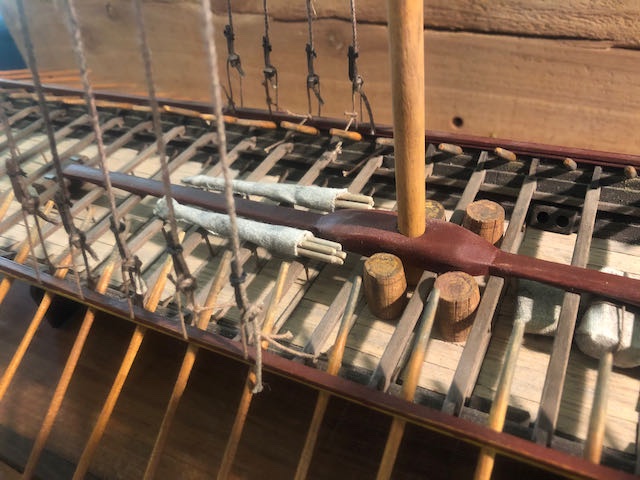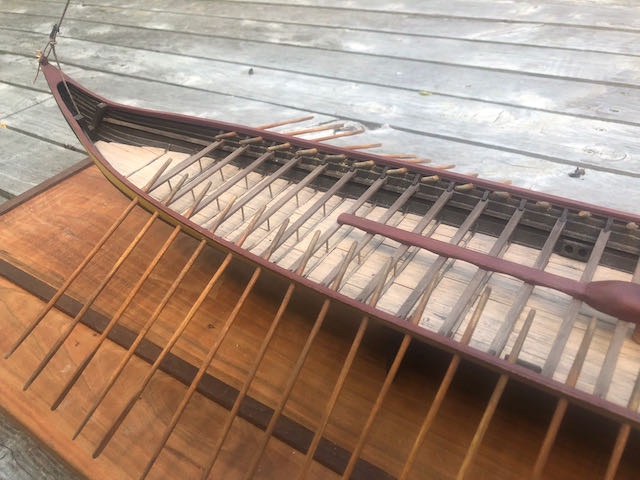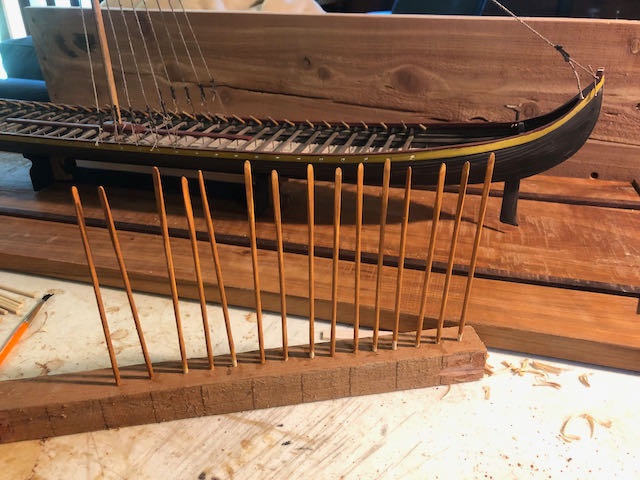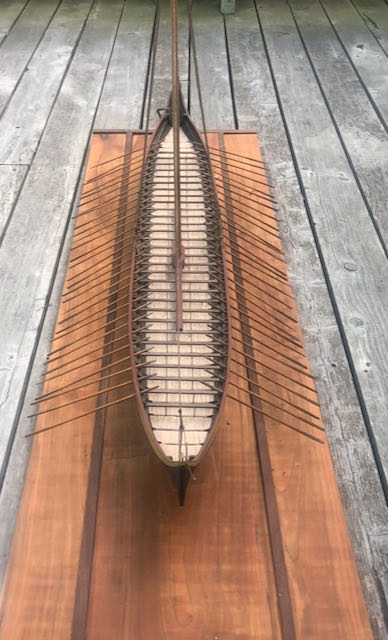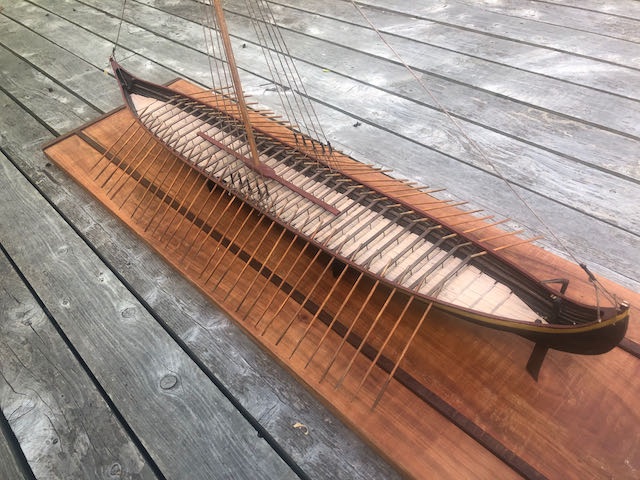-
Posts
3,479 -
Joined
-
Last visited
Content Type
Profiles
Forums
Gallery
Events
Everything posted by Cathead
-
Very cool model. I particularly like the consistent and muted color palette that ties the whole thing together, and the extra thought and detail you put into making it your own. Thanks for sharing and inspiring me to reach higher in my own work.
-
If you're referring to what I think you are, there are no standard measurements, as the idea is to make a jig that matches the curve your hull needs. So you'd need to either trace the curve of the hull or take if off plans (if your kit has them), then use that trace as a template to make your own jig. It doesn't have to be exact, the idea is just to get most of the curve set in the wood before it goes on the model. So, for example, you could hold a piece of paper against the hull where the plank needs to be, then use a pencil to make a rubbing following the approximate curve needed, then use that to drill a series of holes for pegs that would hold a plank in that curve. Does that make sense? Or am I misunderstanding you?
- 62 replies
-
- amati
- greek bireme
-
(and 1 more)
Tagged with:
-
OK, for better or worse, here's the hull with its final detailing arrangements. These are all glued in and no going back. Apologies for the crappy photos, I hurt my knee this morning (nothing permanent, just very stiff) and didn't feel like carrying the model outside for better light with the increased stumbling hazard. You'll get proper photos when it's fully done. This is just to show you what I did. Bow: Paired shields lashed between the thwarts as far back as the mast foot, with three shields lashed to the outer hull. A couple chests in the bow and another angle of the shields: Amidships cargo: Bundles and chests before the mast, barrels around the mast, spear bundles aft: Stern: More shield pairs lashed between the thwarts aft of the mast foot, two more shields on the hull on either side along with a couple stashed in the very stern, and more chests: And an overhead view of the whole thing: Astute eyes will notice that this is only 40 shields for the 60 rowers, but I'm stopping there. Partly laziness in just not wanting to make more shields, but more that I don't see a clear place to store/display any more without the hull starting to look crowded. Maybe it was crowded in real life, but I don't want the model to look too busy. I'm pretty pleased with this overall. It's enough detail to bring the hull to life without really feeling cluttered. Next step is to tighten the standing rigging and install the sail & yard. Actually getting pretty close now since I pre-made that whole assembly. Looks like I'm not quite going to finish by the one-year anniversary (July 5), but I do intend to finish in time to enter this in the NRG's online contest (deadline August 2). Thanks for sticking with me!
-
Heh, thanks. As you can tell, I submitted that a long time ago, but he's got so many submissions it took this long to make it through the queue!
- 599 replies
-
- sidewheeler
- arabia
-
(and 4 more)
Tagged with:
-
I've read that too. I found it entertaining but pretty loose with the accuracy while being kinda boilerplate (all Follett's novels follow the same basic template and get predictable after a while for me). Evening and the Morning basically felt like every one of his cathedral books with a couple words changed to make it sound like a different era. Bernard Cornwell is a far better writer and takes far more care to get his facts and cultures right. You'll find that the books take far more time to give a balanced portrayal of Norse/Danish culture than does the show, which mostly treats them as barbarian invaders and puts all its focus on the proto-English. I don't know if you meant download ebook or audiobook, but the audiobooks for Last Kingdom are quite good. The first few books especially have a fantastic narrator who understands how to use accents.
-
Allan, if you want to get more deeply engrossed, try The Last Kingdom on Netflix, or even better, the series of historical novels it's based on. The books are a fairly accurate account of the Anglo/Norse era of Britain around the time of Alfred the Great, and the TV show does a decent job (it's far more accurate than Vikings), especially the first two seasons when it was British-made. Once Netflix took over, seasons 3 and 4 became more gratuitously American and the Viking characters became more shallow, but it's still entertaining and at its worst is as good as the better parts of Vikings. Of course, that's just my opinion. Glad you're interested now! I certainly don't want this to be my last such vessel, I've learned so much that I want to apply from the beginning on a future build.
-
More detailing updates. I played around with Steven's suggestion of stacking shields under the thwarts/benches and couldn't make it work. The shields are too wide to fit easily and I knocked out a number of the delicate little stanchions supporting the benches. So here's my latest idea: stack some shields in groups of twos vertically between each bench (corresponding to a rower on each side), at least where the mast foot doesn't get in the way: These are loosely placed for demonstration. If I did this for real, I'd glue the pairs together, then glue them to the bench. Then I'd simulate some kind of basic rope lashing holding them in place. I think I like this approach as it lets both sides of the shields be seen, makes them reasonably accessible, and at least makes some functional sense. The rest of the shields I can tuck into corners at bow and stern or maybe hang from the gunwales as suggested above. I'm going to sleep on it before doing anything permanent. I made a cloth cover for the open barrel, lashing it one with some fine line: I think it's good enough for display on the model. Another barrel is underway so I can place one on each side of the mast footing. I made two more bundles of "spears", this time using toothpicks as the shafts. I sanded these down a bit smaller, glued them in bundles around a central dowel, and wrapped them in cloth: The newer ones are at left. I like these a bit better, though I'll use both sets, piling them together. Their length matches the spear held by one of my figurines. The handles are probably still a bit thick, but I think it's close enough for artistic representation. In this approach, the spears and most of the cargo will set centrally surrounding the mast foot. I think this will work out pretty well.
-

Steamboats and other rivercraft - general discussion
Cathead replied to Cathead's topic in Nautical/Naval History
Thanks for sharing that, Balclutha! Samuel Clemens' brother was killed in steamboat boiler explosion along the Mississippi. One of the worst steamboat disasters on the Missouri occurred not far from me, near Lexington MO. Randy, wish I had an answer for you.- 281 replies
-
- Steamboats
- riverboats
-
(and 3 more)
Tagged with:
-
Bolin, I agree, there's no way they would have been stored like that during actual sailing operation. I'm just really struggling to find the balance between artistic display of relevant details and an operationally accurate model. Again, just the fact that I'm displaying it with oars out and sail rigged blows operational accuracy right out of the water, so the question is how much further do I go?
-
Congratulations. Such a beautiful model, and so much care and accuracy in the building of it. Thanks for the inspiration and the time spent to share it.
- 179 replies
-
- longship
- Helga Holm
-
(and 1 more)
Tagged with:
-
Steven, Swords: Yeah, I know they were high-value. Especially any Ulfberts. The barrel idea was artistic license to have a chance to display some. I knew I couldn't justify putting a bunch of axes in a barrel given the physical logistics of it! But you're convincing me it's just not plausible enough even in that context. I think I'll cover the barrel with "oilcloth" since they wouldn't want seawater slopping in no matter what it contained. Spears: Those were the thinnest dowels I had on hand and I was hoping they would blend in to the overall presentation. Though it just occurred to me I could try rounding some toothpicks. Axes: I know these were more common than swords but haven't figured out a good way to make some or display them. Seems wrong to just have them lying around the deck. Viking safety regulators would issue a citation for sure. Shields: My justification for the "turtling" layout was that they were lashed to the thwarts from the underside, so they wouldn't be sliding around. I'm having a devil of a time figuring out what would make sense operationally, since as you observe, shields just don't stack and they have to be accessible but not in the way. And I want to have a bunch visible since I put all that work into making them. What do you think of the few lashed to the side fore and aft? Mark, Shields hanging from the sides really did happen, since some vessels have been found with shield racks built on. The question is really whether it's acceptable to decide that this ship only did that fore and aft of the oars. Various mistakes in construction mean that I can't hang shields between the oars like otherwise might have been done. Balclutha75, I can't accept the museum-quality complement because I know the workmanship level isn't there. It definitely looks good in photos, but any in-person examination would find lots of ways this isn't anywhere close to that level. And I've made various compromises between authenticity and practicality that wouldn't stand up to a real museum examination. But I appreciate the sentiment, as I am pleased with how it's coming together visually. On the oar jig, two notes: It will create a slight paint boundary where the handles go into the jib, because you can't paint all the way down in one go. This is one reason I went with the "rubbed" handle look, because it hides that issue! Also, be careful not to apply to much paint/stain, because if it runs down the handle at all, it can pool where the oar meets the jig and create an unsightly blemish that can't be fully gotten rid of. I have a couple oars where I made this mistake and will be careful to display that spot facing downward.
-
Mark, I agree that in reality there's no way swords would be stored in an open barrel like that. I was thinking of it as an artist's license way to display some weaponry more openly (same reason why the oars will be run out with the sail hoisted). Haven't decided. It may be best just to cover it, as you say. Did a little more staging, trying to work out how to display the shields. Thoughts on having a bunch run along the centerline, and a few hung along the gunwales fore and aft of the oars? Apologies for the photo quality here, the idea is just to show the layout.
-
Playing with some detailing this afternoon. I made up some test parcels wrapped in simulated cloth. Who knows what they are, but they represent supplies the crew doesn't want getting wet. I also made several bundles of "spears", with stub-end shafts sticking out from the end of the wrapping (meant to keep saltwater off the metal tips). I might have wrapped these a little tight, I'm not sure there's actually room in there for the full spears and spearhead, but I don't think it's noticeable in the broader context of the model. The wrapping is the kit's original sailcloth weathered with pastels. What do you all think, tie up the "parcels" like the front two or leave them untied like the back three? And here are details test-placed in context. Large chests at the stern: Large and small chests at the bow, along with an open "barrel" I was thinking of filling with swords. Or maybe it's just a water barrel, like a scuttlebutt? I made this by gluing thin wood strips to a piece of plastic tubing: Parcels and closed barrels tucked into the thwarts: \ Spear bundles just aft of the mast: I like the complexity these add. Not sure how many more I need, I also don't want the model to be too busy, and I still have to figure out where/how to display a bunch of shields. Thoughts on this arrangement?
-
At this point you should consider starting a build log, that's the best context for asking questions about actually building the kit. Here's a thread about how to start a build log. When you do so, let us know here so we can easily find it. Also, it's really hard to diagnose and answer questions without photos of the problem. As for clamps, that really depends on what you're doing. Here's a good thread with some suggestions and photos for different clamps in different contexts. The Modeling Tools and Workshop Equipment section of MSW has lots more information.
-
Oops, just realized druxey did suggest essentially the same thing and I somehow read past it. Sorry, didn't mean to duplicate.
- 160 replies
-
- Model Shipways
- norwegian sailing pram
-
(and 1 more)
Tagged with:
-
That's high praise coming from you. If it was anyone else I'd say read more build logs, but I think you've read them all! So thank you, though I do think there are many other really nice ones out there. I'm really excited to see how various other details I'm working on come together.
-
In an unusual burst of productivity, I made the other 30 oars today. So here's how the ship looks with all 60 set loosely in place: I took one shot of the oar-making process, here's the basic painting jig I set up by drilling holes in some scrap wood: This is really exciting, as now the focus turns to final details, which I haven't wanted to install until I was sure I had the oars right. Now I just have to decide how obsessive I'm going to get about said details. Since I started this log on July 5, 2020, I think I'll be able to have this done by its one-year anniversary. Not bad for a project I foolishly thought would only take a few months.
-
So exciting to hear! Thanks for keeping us updated. You're doing a great job.
- 89 replies
-
- Enterprise
- first build
-
(and 2 more)
Tagged with:
-

Steamboats and other rivercraft - general discussion
Cathead replied to Cathead's topic in Nautical/Naval History
Great description and detail! Those were really common for decades until steamboats finally did them in. They had a long tail of use since it was often still easier and cheaper to slap one together and transport goods yourself than deal with steamboat rates and schedules. They were common on the Missouri, too. Another benefit was that they could be broken up into salable timber in New Orleans, adding to the collective income. Here are two versions of a painting by contemporary Missouri artist George Caleb Bingham. The first is from 1847, during the actual flatboat era: The second is from 1877. Bingham apparently repainted it, changing some details. This was done after the flatboat era had ended. The second one looks especially like a Missouri River setting. I was amused at the following description of the painting from the National Gallery of Art: This was written by someone with no knowledge of river transportation. These men certainly did NOT row this craft upstream. There aren't even oars in the normal sense. The long pole sitting lengthwise is a sweep, used for navigation and gentle propulsion, but in no way capable of fighting the current of the Missouri or Mississippi Rivers to any meaningful degree. They're clearly floating downstream, as shown by the man at the steering oar at the center back of the flatboat.- 281 replies
-
- Steamboats
- riverboats
-
(and 3 more)
Tagged with:
About us
Modelshipworld - Advancing Ship Modeling through Research
SSL Secured
Your security is important for us so this Website is SSL-Secured
NRG Mailing Address
Nautical Research Guild
237 South Lincoln Street
Westmont IL, 60559-1917
Model Ship World ® and the MSW logo are Registered Trademarks, and belong to the Nautical Research Guild (United States Patent and Trademark Office: No. 6,929,264 & No. 6,929,274, registered Dec. 20, 2022)
Helpful Links
About the NRG
If you enjoy building ship models that are historically accurate as well as beautiful, then The Nautical Research Guild (NRG) is just right for you.
The Guild is a non-profit educational organization whose mission is to “Advance Ship Modeling Through Research”. We provide support to our members in their efforts to raise the quality of their model ships.
The Nautical Research Guild has published our world-renowned quarterly magazine, The Nautical Research Journal, since 1955. The pages of the Journal are full of articles by accomplished ship modelers who show you how they create those exquisite details on their models, and by maritime historians who show you the correct details to build. The Journal is available in both print and digital editions. Go to the NRG web site (www.thenrg.org) to download a complimentary digital copy of the Journal. The NRG also publishes plan sets, books and compilations of back issues of the Journal and the former Ships in Scale and Model Ship Builder magazines.



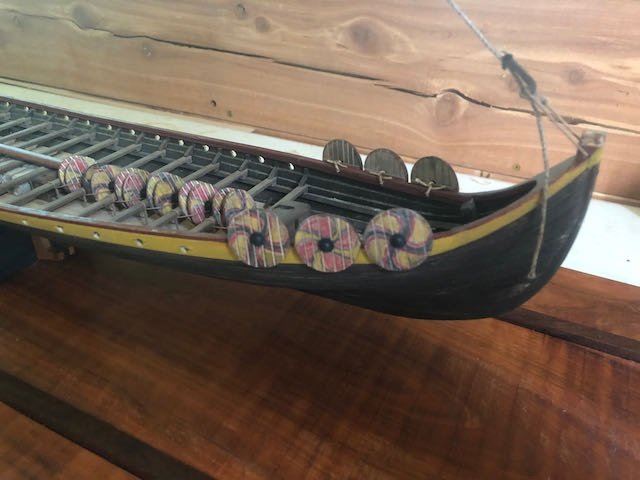
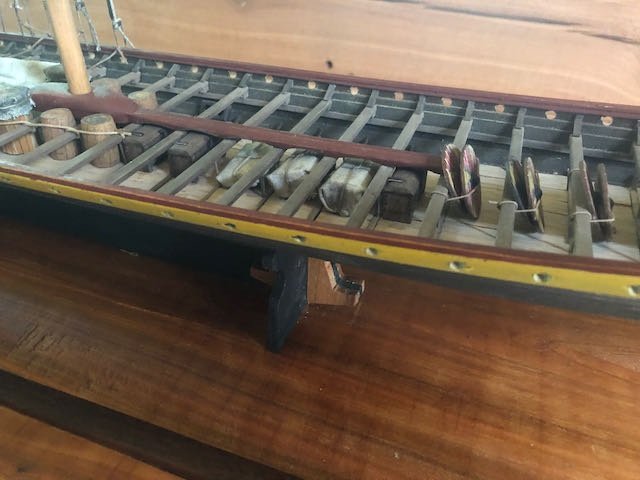
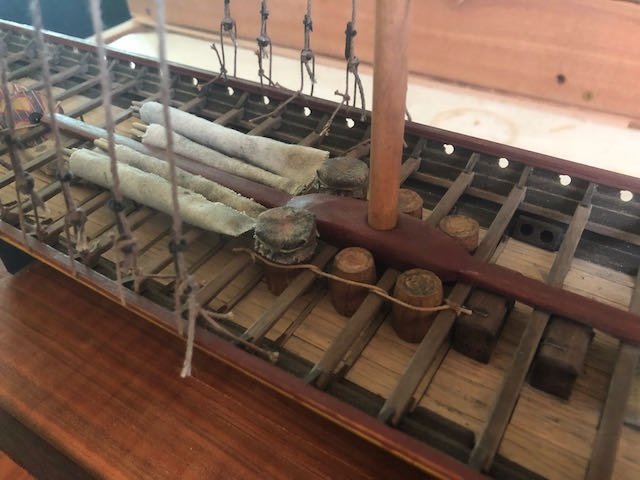
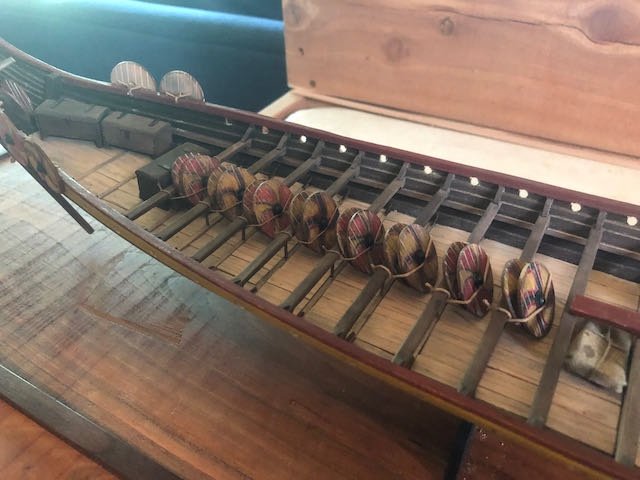
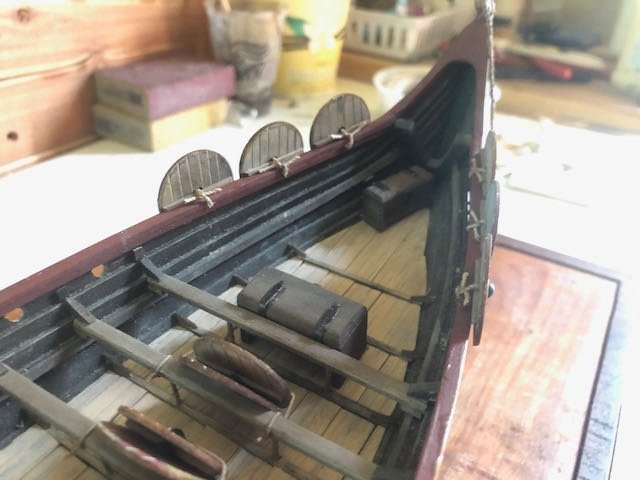
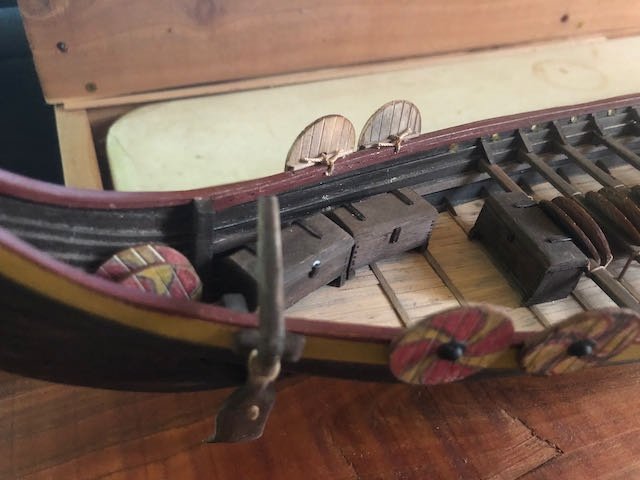
.jpeg.16e1d70852ff17475326b628d7aa0a17.jpeg)

